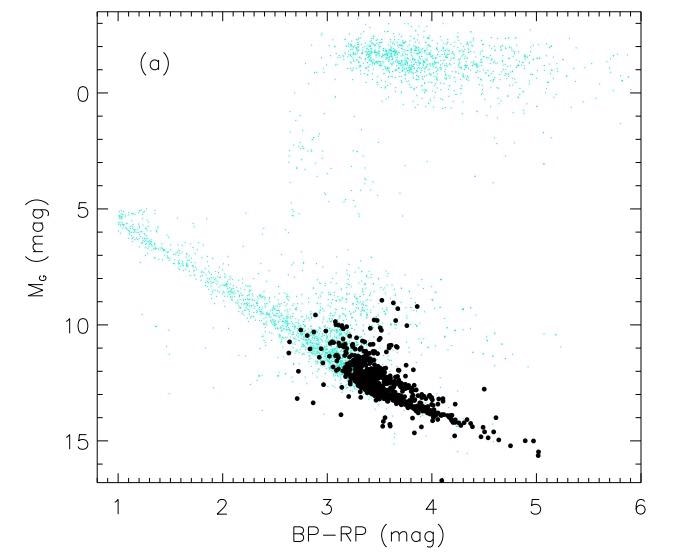Reviewed by Alex SmithMay 9 2022
A team of researchers led by Dr. Youfen Wang and Professor Ali Luo from the National Astronomical Observatories of the Chinese Academy of Sciences (NAOC) found 734 ultracool dwarfs, which are candidates for brown dwarfs, using LAMOST DR7 low-resolution spectral data.
 Color-absolute magnitude diagram in Gaia photometry system. The black dots indicate the ultracool dwarf sample and the cyan dots indicate the comparison sample. Image Credit: Youfen Wang.
Color-absolute magnitude diagram in Gaia photometry system. The black dots indicate the ultracool dwarf sample and the cyan dots indicate the comparison sample. Image Credit: Youfen Wang.
This is the most homogeneous ultracool dwarf sample ever discovered, containing a wealth of star parameter data. The journal Astronomy & Astrophysics published related observations.
Dwarfs, which are ultracool, have a little bulk, a red tint, and a faint brightness. They are, therefore, incredibly hard to observe, and observation instruments are extremely expensive.
To some extent, this work highlights LAMOST’s dark-end observational capabilities, as well as the feasibility of researching ultracool dwarfs with the big aperture spectroscopic survey telescope.
Ultracool dwarfs are found in the lower right quadrant of the color-absolute magnitude map, encompassing the spectral types late M (M7-M9), L, T, and Y, the latter three of which are particularly specified for this type of astronomical object due to their faintness. Based on their masses, late M and early L dwarfs can be brown dwarfs or regular low-mass stars, while mid-L (L3) through L9, T, and Y types are brown dwarfs if their masses are between 13 and 75 times that of Jupiter.
Brown dwarfs are substellar objects that lack stable hydrogen fusion in their cores and are referred to as “failed stars” since they will never grow along the main sequence. They serve as a link between stars and planets, and they are important in studies of the Milky Way’s creation history, the initial mass function, and heated planetary atmospheres.
Meanwhile, late M-type ultracool dwarfs are useful for researching chemical reactions and physical processes inside astronomical objects near the star-brown dwarf boundary. They are also great for looking for terrestrial planets (rocky planets) since they are so dim that very low-mass terrestrial planets can be seen orbiting them.
The researchers chose over 10,000 late M-type spectra from over 700,000 M-type spectra in the LAMOST DR7 data, and 734 ultracool dwarfs were eventually discovered through visual inspection and spectra comparison.
Two-thirds of the late M ultracool dwarfs were seen spectroscopically for the first time by LAMOST, making this the largest late M ultracool dwarf sample offered in a single publication with rich stellar parameter data derived homogeneously.
80% of these ultracool dwarfs are within 326 light-years of the Earth, with the most distant one being 1174 light-years away. Their kinematic ages are around 300 million years, and their kinematic properties and metallicities are similar to those of disc stars in the Milky Way.
All of the ultracool dwarfs in the sample are brown dwarf contenders, with 77 having prominent lithium absorption lines in their spectra, indicating a strong likelihood of being brown dwarfs. Furthermore, six broad binaries were detected for the first time, and their companions may be considerably less massive, making them most likely brown dwarfs.
This ultracool dwarf sample has important scientific application value for the study on the properties and evolution of ultracool dwarfs that are very difficult to observe, especially brown dwarfs.
Ali Luo, Study Corresponding Author and Professor, Chinese Academy of Sciences
Researchers may be able to identify more and farther brown dwarfs in the coming years, thanks to the accumulation of LAMOST spectral data and the launch of the Chinese Space Telescope (CSST), opening up new avenues for research into the formation process and internal condition of brown dwarfs, which are currently understudied in the field of stellar physics.
Journal Reference:
Wang, Y-F., et al. (2022) Ultracool dwarfs identified using spectra in LAMOST DR7. Astronomy & Astrophysics. doi.org/10.1051/0004-6361/202142009.